Israt Zerin1, Eshita Datta2
1Department of Textile Engineering, Southeast University, Dhaka, Bangladesh
2Department of Textile Engineering, Bangladesh University of Business and Technology (BUBT), Dhaka, Bangladesh
Correspondence to: Israt Zerin, Department of Textile Engineering, Southeast University, Dhaka, Bangladesh.
| Email: |  |
Copyright © 2018 The Author(s). Published by Scientific & Academic Publishing.
This work is licensed under the Creative Commons Attribution International License (CC BY).
http://creativecommons.org/licenses/by/4.0/

Abstract
In today’s global world the importance of filtration is become necessary in our day to day life as the rapid development of the countries all over the world causing pollution in the environment. Separation of insoluble substance from a fluid, by allowing it to pass through a porous material is called filtration. For filtration of air and water different technology has been implemented and continuously improving the quality of filtration day by day. This paper leads to use of filter cloth on different processes and will make the clear understanding on the factors that directly or indirectly influence of the quality and quantity of filtration using different kinds of filter cloth.
Keywords:
Filter cloth, Textile technology, Multi-layer fiber, Filtration resistance
Cite this paper: Israt Zerin, Eshita Datta, A Review Article on Applications of Filter Cloth, International Journal of Clothing Science, Vol. 5 No. 1, 2018, pp. 1-6. doi: 10.5923/j.clothing.20180501.01.
1. Introduction
The separation of solids from liquids or gasses by textile filter media is an essential part of countless industrial processes, contributing to purity of product, savings in energy, improvement in process efficiency, recovery of precious material and general improvement in pollution control. Complicated structure and thickness of Textile materials, particularly woven and non-woven, are suitable for filtration. [1]Filtration resistance of a filter cloth may increase with warp and weft density and twist of fabrics. Porosity and air permeability of fabric is also plays important role in filtration process. [2] Textile Filtration is used in several ways, separating, and purifying liquids and solids, cleaning gases and effluents, absorbing dirt, fumes, and oil. They are used in industrial processes, in cars and other types of transport, building air conditioning systems, personal protection and at homes.Filtration process consists of two main processes namely filtration and cleaning of filters. Woven, knitted and nonwoven textiles materials are generally used as filter fabrics. Nonwoven material yields better filtration efficiency compared to other materials. Needle felt nonwoven are mostly used as filtration fabrics. Various type of textile fibers are used as nonwoven filtration fabrics depends upon its performances. Nonwoven fabrics described as a random fibrous web formed by either mechanical, wet or air laid means and having interconnecting open area throughout the cross-section are able to remove a percentage of particulate from liquid or gaseous fluids streams flowing through it. It is common practice in villages in Bangladesh to use cloth, frequently a flat, unfolded piece of an old sari, to filter home-prepared drinks. [3] The researchers studied the application of this technique to drinking water, with folded cloth. They studied the pore size of the cloth, the effect of folding of the cloth on the effective pore size, determine the ability of the cloth to remove particles and plankton, as well as the effect on rates of cholera when used in a Bangladesh village. [4]
2. Development of Filter Cloth
Design of filter media depends on thermal and chemical conditions, filtration requirements, equipment consideration and cost. The type of polymer which should be selected for filtration depends on the thermal and chemical condition of the material which is going to be filtered. Natural fibers like cotton which can produce highly efficient media for filtration but in terms of longevity it is limited for use in comparison with synthetic fibers. Polyamide, polyester and polypropylene may used as filter cloth but most effective is PTFE (Polytetra fluoroethylene) for manufacturing filter bag as it is resistance to all chemicals and it is biostable, biocompatible and hydrophobic in nature. Due to low melting point, low thermal conductivity and low load carrying capacity it is only used for light low speed applications.The filter fabric is used to effect the maximum separation of particles from liquids, absolute clarity is not always necessary. In certain gravity- or vacuum-assisted screening operations the filter fabric is simply designed to capture particles greater than a specific size and in other filtration systems a measure of solids in filtrate can be tolerated before cake filtration takes over and the necessary clarity is achieved.Different fibrous structures, such as mono, homogeneous over the entire volume, and multilayer (composed of layers varying in porosity or fiber diameter), are manufactured and used for specific purposes. Bio fouling still remains an unsolved problem. The melt-blown technology, which is equipped with a twin-screw extruder, is able to produce fibrous filters with antibacterial nano particles located on the surface. The bacteriostatic effect reduces the bio fouling effect at the outer surface of the filter. [5]The nanocomposite membranes showed a promising antibacterial activity against Gram-negative bacteria. The nano composite membranes prepared by the in situ (the silver nano particles presented nano cubic and spherical morphologies and the particles were preferentially distributed on the top and bottom surfaces of the membrane) method exhibited a better antibacterial activity, in comparison to those prepared by ex situ (the silver nano particles were synthesized and further dispersed into the polymer solution, spherical-like silver nano particles were found to be uniformly distributed in the internal pores), and also a decrease in 90% E. coli adhered cells compared to the pristine Polysulfone membranes. The in situ procedure can be considered a feasible, simple, and reproducible methodology to prepare anti-biofouling polysulfone membranes containing silver nanoparticles. [6]
2.1. Classification of Filter Cloth Based on Raw Materials
There are several types of fiber used in filtration on woven structure.Ÿ Cotton Filter ClothŸ Nylon Filter ClothŸ Polyester Filter ClothŸ Polypropylene Filter ClothŸ Vinylon Filter Cloth
2.1.1. Cotton Filter Cloth
For better gasket effect during filtration, cotton filter cloth will swell in alkali solutions. Ordinary cotton cloths are suitable for neutral filter pulp under 100°C for acid filtration up to 20°C and alkali solution under 10°C.With the development of synthetic fabrics like polyester, cotton filter cloths are decreasing for weak resistance against mildew and instability of dimensions. However, cotton filter cloth produces no pollutions and poisoned substances to the filtration.
2.1.2. Nylon Filter Cloth
Nylon filter cloth have the greatest resistance to rubbing among the other three frequently used filter fabrics including polypropylene, polyester and cotton. It is often found in filtration applications of dusts and wet solids that are scratching cloth. So, rubbing resistance plays an important factor.To meet various applications, Nylon filter cloths including spun and multifilament can be woven into plain, leno and stain patterns for fine particle filtration. Nylon filter cloth is used in ceramics, mining, metallurgy, waste water treatment.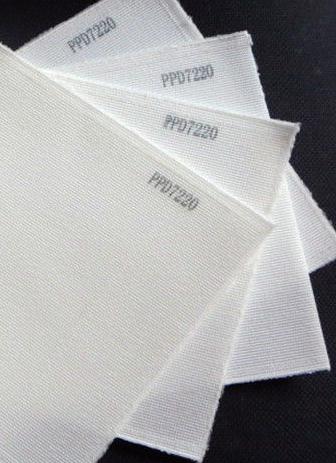 | Figure 1. Nylon Filter Cloth |
Advantages of nylon filter clothŸ Excellent abrasion resistance;Ÿ Excellent cake release.Ÿ Fine particle filtration.Ÿ Ideal for low temperature.Ÿ High tensile strength.Ÿ Good elasticity is ideal for continuous flexing purposes.Ÿ Suitable for caustic alkali atmosphere like dyestuffs.Ÿ Working temperature: 120°C (constant); 135°C (surge).
2.1.3. Polyester Filter Fabric
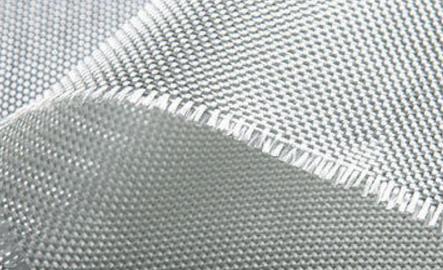 | Figure 2. Polyester Filter Fabric |
As an important factor of filter press, polyester filter cloth has been widely accepted by an increasing number of manufacturers and users of filter press for its strongest acid-resistance and excellent resistance against elevated temperature up to 150°C Surface finishes can be singed, calendared and heat set, each of which has its special property and purpose.Excellent combination properties such as sleekness, high tensile strength, wear resistance and permeability, empower it to be an effective and popular filtration media. Various types of polyester yarns are provided to satisfy particular applications. For example, multifilament filter cloth not only strengthens its tensile strength but also ensures good cake release. Different woven patterns including plain, stain and twill, are designed with special purposes.Polyester may used as filter cloth in chemical plant, fertilizer plant, pharmaceutical, sugar, separation of oil and water, food and beverage.Advantages of polyester filter clothŸ High performance resistance against most organic acids except high concentrations of nitric, sulfuric and carbolic acids;Ÿ High tensile strength;Ÿ Elongation: 20% - 50%;Ÿ High operating temperature: up to 150°C;Ÿ Excellent abrasive resistance;Ÿ Good resistance to weak most oxidizing agents;Ÿ Good filter cake release;Ÿ Long life span.
2.1.4. Versatile Polypropylene Filter Cloths
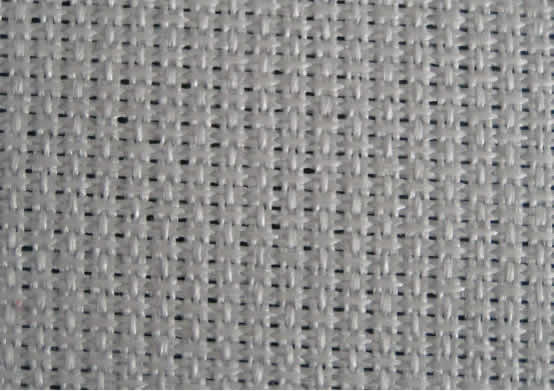 | Figure 3. Multifilament Polypropylene Filter Cloth [7] |
Polypropylene filter cloth (or PP filter cloth) is extensively used in liquid-solid filtration for its excellent filter cake release and good resistance to most acids and alkalis. Due to super low moisture absorption, polypropylene is a preferred selection for dye production.Woven polypropylene cloths can be fabricated by monofilament, staple and multifilament in twill, plain and stain patterns to meet different filtration purposes. Its constant working temperature is 90°C.Polypropylene filter cloth widely used in mine, metallurgy and waste water fields. Polypropylene filter cloth may used in chemical, pharmaceuticals, sugar, non-ferrous metal smelting, sewage treatment.Advantages of PP filter clothŸ Sleekness surface for optimum cake release;Ÿ Shorten filter cycle;Ÿ Lightest weight among synthetic fabrics;Ÿ Excellent gas permeability;Ÿ Free of mildew and oxidation.Ÿ Good resistance against acids, alkalis and reducing agents.Ÿ Available for large to fine particle filtration.
2.1.5. Vinylon Fabric Filter Cloths
Vinylon filter cloth has an outstanding resistance against alkali and good moisture absorption. Its durability is as long as two times of cotton cloth. Vinylon fiber is endowed with high abrasion resistance. At present, Vinylon filter cloth is only available in staple or stun yarns and plain woven pattern. Vinylon filter cloth used in ceramics, chemical industry, metallurgy, food and beverage, suitable for shade cloth and tour tent.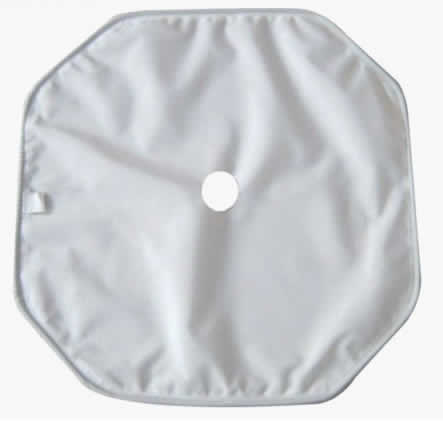 | Figure 4. Vinylon Filter Cloth Widely Used in Alkali Applicants [6] |
Advantages of Vinylon fiter clothŸ Optimum alkali resistanceŸ Good abrasion resistanceŸ Moisture absorption
2.2. Non Woven Filter Cloth
2.2.1. Polypropylene Felt Filter Cloth
Polypropylene felt filter cloth is a kind of non-woven fabric which has no warp and filling lines and easy to tailor and sew. It is endowed with the profits of woven polypropylene cloth such as excellent resistance to chemicals, acid and alkali solutions and elevated temperature as well as great dimensional stability. Calendered surface contributes to cake release and shorten filter cycle. Its normal working temperature is up to 88°C. In addition, polypropylene cloth can be reused and will not produce second pollution to the environment. | Figure 5. Polypropylene Felt Cloth |
Polypropylene felt filter cloths are treated by different finishes including plain, singed and glazed, all of which are especially designed for special filtration purposes. To further improve its sealing property, a latex border can be used to the custom cloths. It is also used as duct collection in dust-removing equipment. Polypropylene felt filter cloth may used in coal washery, steel making factory, ceramic, printing and dying. [7]Advantages of felt filter cloth [8] [9]Ÿ Smooth surface, uniform micropore distribution and good cake release;Ÿ Filtration precision reach 2 micron;Ÿ Widest breadth is 6 meters;Ÿ Friendly to environment for its excellent hydrolysis property.
3. Classification of Filter Cloth According to Industrial Processors
Woven filter cloth can be widely used in industry filtration, such as fine chemical industry, petrochemical industry, mineral industry, food industry, and pharmaceuticals industry. [10]
3.1. Plate and Frame Filter Press
 | Figure 6. Plate and Frame Filter Press |
Plate-and-frame (type) filter press is a device for solid-liquid separation with plate, frame as filter room where liquid was transferred into by conveying pump, solid-liquid separation will be achieved by filter media. Filter Press Cloth in PET, PA, PP, are used for plate, and frame filter press, chamber press and other presses. Widely used in liquid/solid, separation gas filtration and dust collection. Acid-resistance, alkali resistance, high strength, good permeability, high tensile elongation. Good abrasion resistance, easy separation. It specially apply to models with large capacity, it can ensure good filtering effect.- ApplicationFilter presses are used in a huge variety of different applications, from dewatering of mineral mining slurries to blood plasma purification. At the same time, filter press technology is widely established for ultrafine coal dewatering as well as filtrate recovery in coal preparation plants. The use of filter press is very beneficial to plant operations, since it offers dewatering ultraclean coal as product, as well as improving quality of water removed to be available for equipment cleaning.- EfficiencyPlate and frame filter press produce up to 99% of solids recovery, and the moisture left in the cake commonly ranges from 15% to 20%. During cake washing, 90% of the filtrate can be removed by the wash liquid.
3.2. Pan Filter
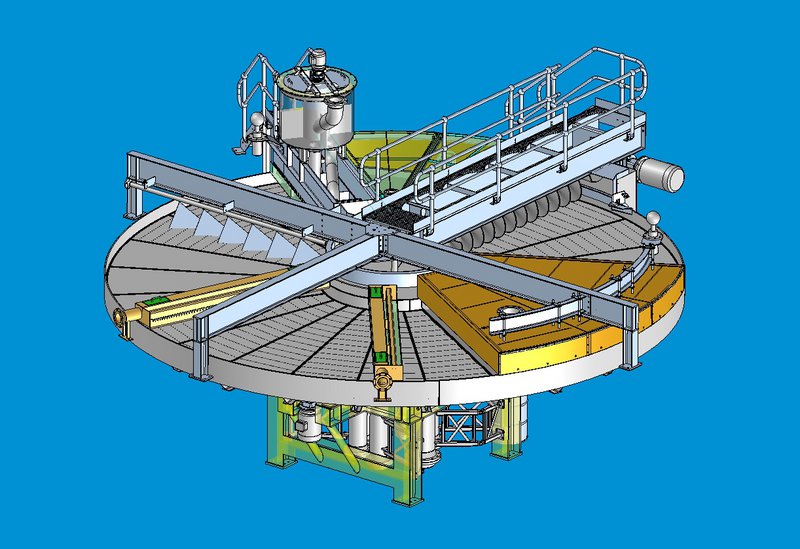 | Figure 7. Pan Filter |
A pan filter is a chemical equipment used in continuous solid-liquid filtration. It is formed by a number of trapezoidal pans arranged in circle. At the center of the equipment there is the main valve which is connected to every pan through pipes. The pans are rotating continuously around the main valve, which provides the air or the vacuum necessary for the operation. In each pan it is carried out the filtration in a cyclic process that involves these stages: Pan filter has a large filtration area and high efficiency. Blanking on flat plate taking advantage of its own gravity, thereafter the slurry in the state of vacuum is relatively long, which contributes to dehydration. It is especially used for alumina industry. Filter cloth for alumina industry’s life usually is about 2 months, index of aridity is about 4%-8%.
Pan filter has a large filtration area and high efficiency. Blanking on flat plate taking advantage of its own gravity, thereafter the slurry in the state of vacuum is relatively long, which contributes to dehydration. It is especially used for alumina industry. Filter cloth for alumina industry’s life usually is about 2 months, index of aridity is about 4%-8%.
3.3. Disc Filter
 | Figure 8. Disc Filter |
A disc filter is a type of water filter used primarily in irrigation, similar to a screen filter, except that the filter cartridge is made of a number of discs stacked on top of each other like a pile of poker chips. The water passes through the small grooves in between and the impurities are trapped behind. The higher or lower filtration quality, defined this as the higher or lower quantity and size of particles that the filtering element is able to retain, depend on the geometry and size of the channels, the length of these and the number of generated intersection points.- FunctionŸ Disc filters are designed for filtration of large volumes of waste water with demands for high quality of cleaned water.Ÿ They are applied for filtration of water from waste water treatment plants, in fish farms, in the food and paper industries and for recycling of cooling water in power plants. In some cases, these filters can be used for recovery of valuable substances from process waters.- PrincipleThe basic filtering element is a fabric-coated filter segment. Water flowing into the inner space of the filter segment flows through the fabric while fine impurities are trapped on the cloth. The segments are fixed on the disc shaft. Twelve segments make up one disc. The number of discs determines the capacity, i.e. the size of the filter.- AdvantagesŸ Filtration of large flows up to 500 L/sŸ Filtration from 5μmŸ High quality of cleaned waterŸ Low built-up area demands in the ratio to filter capacityŸ Alternative to micro-strainer drum filtersŸ Low investment and operating costsŸ High cleaning reliabilityŸ High construction resistance to wear and damage
3.4. Centrifuge Filter
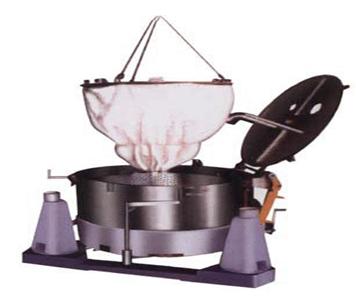 | Figure 9. Centrifuge Filter |
A centrifugal filter is a type of barrier that can be used to separate materials after they are spun in a centrifuge. When a centrifuge is outfitted with a filter, high density solids or liquids can be effectively removed from low density liquids. In many industries, a centrifugal filter is used to separate waste products from certain liquids, which can then be reused by the company. A centrifugal filter is usually used to separate solid matter from a liquid suspension. This allows the liquid portion of the material to be recycled. Solid matter that is removed from a liquid through a centrifugal filter usually escapes in the form of slurry. The wet material can then be dried, either in a special holding container within the centrifuge or in a separate container until it can be disposed. They are used by a number of different industries. They can be used to clarify waste oil, clean out glass or ceramic grinding fluids, or remove small particles of metal from liquids. The liquid remaining after the centrifugal filtration can often be used again once it is clean. This cuts down on waste materials and reduces a company’s expenses.
3.5. Bag Houses Filter
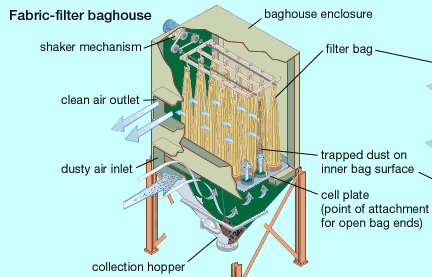 | Figure 10. Bag-house filter |
Bag houses filter use filtration to separate dust particulates from dusty gases. They are one of the most efficient and cost effective types of dust collectors available and can achieve a collection efficiency of more than 99% for very fine particulates. Dust-laden gases enter the baghouse and pass through fabric bags that act as filters. The bags can be of woven or felted cotton, synthetic, or glass-fiber material in either a tube or envelope shape. The housing contain the bags, cages, reverse pulse-cleaning system, access doors and compressed air manifold. Side access units have access door on side of housing. Top access units have access doors on top of the clean-air plenum or optional walk-in plenum.In air filtration the nonwoven fabric have some advantages over the woven fabric for dry filtration applications due to their unique characteristics. Nonwoven filters for dry filtration can be characterized as high-tech products. Non-woven is highly used in the filtration and it gives the best result and due to the use of this the environment should be harmless and the hygienic to the human being to survive. [11]The flow resistance of the produced composite filters is evaluated by means of air permeability measurements. The electro-spun fibres have diameters ranging from about 70 - 500 nm and are interconnected each other to form thin webs that have very small pore size. After the electro-spinning treatment, the air permeability of the filter media decreases 6 - 17 times showing a significant change of flow resistance that can be controlled by the thickness of nano-fibres layer and the pore size. High efficiency nano-microfibres composite filters could be used in a wide range of applications, ranging from air cleaning for automotive to environment conditioning or liquid filtration. [12]Filtration behaviour of woven and nonwoven Fabrics observed and it is influenced by air flow rate and pressure drop. [13]Nonwovens can be engineered very precisely to meet exacting specifications and stringent regulatory requirements for the filtration of air, liquid, dust, gas etc. Nonwoven webs have high barrier properties, good stability and strength at extremely high temperatures; they can filter almost anything ranging from macro to nano scale particle sizes. [14]
4. Conclusions
This paper discussed on the raw material used in production of filter cloth with advantages and disadvantages. For environmental concern polypropylene cloth is better as it can be reused.Filter cloth is used in different type of devices successfully like plate and frame filter press, pan filter, disc filter, centrifugal filter and bag house filter.
References
| [1] | Sakpal P.P., Landage S.M. and Prof. Dr. Wasif A.I., “Application nonwovens for water filtration” in International Journal of Advanced Research in Management and Social Sciences, 2013, Vol.2 (2), 28-47. |
| [2] | Horrock A R and Anand S C, Handbook of Technical Textiles, 2000, Woodhead Publication. |
| [3] | Colwell RR, Huq A, Islam MS, et al., “Reduction of cholera in Bangladeshi villages by simple filtration” in Proc Natl Acad Sci USA., 2003, 100 (3), 1051–1055. |
| [4] | Huq, Anwar; Mohammed Yunus; Syed Salahuddin Sohel; Abbas Bhuiya; Michael Emch; Stephen P. Luby; Estelle Russek-Cohen; G. Balakrish Nair; R. Bradley Sack; Rita R. Colwell. Awabdeh, “Simple sari cloth filtration of water is sustainable and continues to protect villagers from cholera in matlab, Bangladesh”, 2010, MBio. Vol. 1 (1), e00034–10. doi:10.1128/mbio.00034-10. |
| [5] | Ewa Sztuk - Sikorska, Leon Gradon, “Biofouling reduction for improvement of depth water filtration, filter Production and testing”, Chemical and Process Engineering, 2016, Vol.37 (3), 319-330, doi: 10.1515/cpe-2016-0026. |
| [6] | Andrade, P.F., de Faria, A.F., Oliveira, S.R., Arruda, M.A.Z., Gonçalves, M.d.C., “Improved antibacterial activity of nanofiltration polysulfone membranes modified with silver nanoparticles”, Water Research (2015), doi: 10.1016/j.watres.2015.05.006. |
| [7] | Boegger homepage on filtercloth. [Online]. Available: http://www.filtercloths.org/filter-cloth/polypropylene-filter-cloth.html. |
| [8] | Sabit Adnoor, Handbook of Technical Textile, 2nd Edision, Woodhead publication, 2016. |
| [9] | S. J. Russell, Handbook of Nonwoven, 1st Edision, Woodhead publication, 2006. |
| [10] | Filmedia on best filter. [Online]. Available: http://best-filter.com/product/application-of-woven-filter-cloth/. |
| [11] | Inda, Association of the non-woven fabrics industry, Available: http://www.inda.org/about-nonwovens/nonwoven-markets/filtration. |
| [12] | Prof. U.J. Patil, Filtration in textile, Indian Textile Journal, 2010, 81-86. |
| [13] | Kothari V K, Das A and Sing S, “Filtration behavior of woven and nonwoven fabrics, Indian journal of fibre and textile research, 2007. |
| [14] | Prof. L.G. Patil, Aniket Bhute, Pradinv Bhokare, “Nonwoven for Filtration”, Textile Today, Web. https://www.textiletoday.com.bd/nonwoven-for-filtration/,2014. |










 Pan filter has a large filtration area and high efficiency. Blanking on flat plate taking advantage of its own gravity, thereafter the slurry in the state of vacuum is relatively long, which contributes to dehydration. It is especially used for alumina industry. Filter cloth for alumina industry’s life usually is about 2 months, index of aridity is about 4%-8%.
Pan filter has a large filtration area and high efficiency. Blanking on flat plate taking advantage of its own gravity, thereafter the slurry in the state of vacuum is relatively long, which contributes to dehydration. It is especially used for alumina industry. Filter cloth for alumina industry’s life usually is about 2 months, index of aridity is about 4%-8%.


 Abstract
Abstract Reference
Reference Full-Text PDF
Full-Text PDF Full-text HTML
Full-text HTML